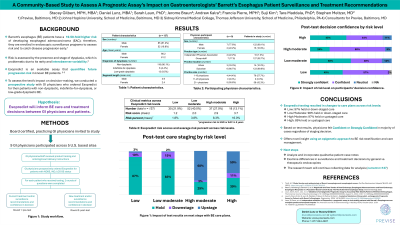Sunday Poster Session
Category: Esophagus
P0486 - A Community-Based Study to Assess a Prognostic Assay’s Impact on Gastroenterologists’ Barrett’s Esophagus Patient Surveillance and Treatment Recommendations
Sunday, October 27, 2024
3:30 PM - 7:00 PM ET
Location: Exhibit Hall E

Has Audio

Dan Lunz, MBA
Previse
Halethorpe, MD
Presenting Author(s)
Stacey Gilbert, MPH, MBA1, Daniel Lunz, MBA1, Sarah Laun, PhD1, Jerome Braun, PhD1, Andrew Kalra, MD2, Suji Kim, BA3, Francia Pierre, MPH1, Tara Maddala, PhD1, Stephen J.. Meltzer, MD4
1Previse, Baltimore, MD; 2Sidney Kimmel Medical College at Thomas Jefferson University, Baltimore, MD; 3Previse, Halethorpe, MD; 4Johns Hopkins University, Baltimore, MD
Introduction: Esopredict is an epigenetic assay that uses DNA methylation to identify early signals of neoplastic progression by stratifying patients with non-dysplastic (NDBE), indefinite-for-dysplasia (IND), or low-grade dysplasia (LGD) Barrett’s esophagus (BE) who may be at risk of developing high grade dysplasia (HGD) and esophageal adenocarcinoma (EAC) within 5 years. The purpose of this single arm prospective study is to determine whether Esopredict results influence gastroenterologists’ changes to BE treatment and/or surveillance recommendations.
Methods: We analyzed pre- and post-Esopredict results survey data for 80 de-identified patient cases from 8 participating gastroenterologists at 5 GI specialty practices. Before ordering Esopredict, participants were surveyed about their selected patients’ sex, age, diagnosis, clinical guidance, and confidence. After reviewing each patient’s results, participants were surveyed again to determine whether their treatment or surveillance recommendations and confidence had changed.
Results: Post-Esopredict clinical recommendations changes to hold, upstage, or downstage care based on each patient’s test result risk level were as follows: Low Risk (72%, 11%, and 17%, respectively), Low Moderate (59%, 37%, and 4%, respectively), High Moderate (38%, 50%, and 12%, respectively), and High Risk (27%, 45%, and 27%, respectively). A higher percentage of results fell in Low Risk (26%) and Low Moderate (39%) categories for NDBE patients and High Moderate and High-Risk categories for patients with IND (40% and 40%, respectively) and LGD (38% and 31%, respectively). All participants expressed confidence in decisions based on Esopredict results and that Esopredict provided clinical value in determining a care plan with their patients. A total of 9 patients’ post-Esopredict recommendations moved from no active treatment to treatment using radiofrequency ablation (11.3%) and 3 patients previously recommended for radiofrequency ablation were down staged to surveillance (3.8%).
Discussion: This study further validates Esopredict as an assay that helps gastroenterologists confidently guide treatment and surveillance recommendations for patients with BE that have not progressed to HGD or EAC.
Disclosures:
Stacey Gilbert, MPH, MBA1, Daniel Lunz, MBA1, Sarah Laun, PhD1, Jerome Braun, PhD1, Andrew Kalra, MD2, Suji Kim, BA3, Francia Pierre, MPH1, Tara Maddala, PhD1, Stephen J.. Meltzer, MD4. P0486 - A Community-Based Study to Assess a Prognostic Assay’s Impact on Gastroenterologists’ Barrett’s Esophagus Patient Surveillance and Treatment Recommendations, ACG 2024 Annual Scientific Meeting Abstracts. Philadelphia, PA: American College of Gastroenterology.
1Previse, Baltimore, MD; 2Sidney Kimmel Medical College at Thomas Jefferson University, Baltimore, MD; 3Previse, Halethorpe, MD; 4Johns Hopkins University, Baltimore, MD
Introduction: Esopredict is an epigenetic assay that uses DNA methylation to identify early signals of neoplastic progression by stratifying patients with non-dysplastic (NDBE), indefinite-for-dysplasia (IND), or low-grade dysplasia (LGD) Barrett’s esophagus (BE) who may be at risk of developing high grade dysplasia (HGD) and esophageal adenocarcinoma (EAC) within 5 years. The purpose of this single arm prospective study is to determine whether Esopredict results influence gastroenterologists’ changes to BE treatment and/or surveillance recommendations.
Methods: We analyzed pre- and post-Esopredict results survey data for 80 de-identified patient cases from 8 participating gastroenterologists at 5 GI specialty practices. Before ordering Esopredict, participants were surveyed about their selected patients’ sex, age, diagnosis, clinical guidance, and confidence. After reviewing each patient’s results, participants were surveyed again to determine whether their treatment or surveillance recommendations and confidence had changed.
Results: Post-Esopredict clinical recommendations changes to hold, upstage, or downstage care based on each patient’s test result risk level were as follows: Low Risk (72%, 11%, and 17%, respectively), Low Moderate (59%, 37%, and 4%, respectively), High Moderate (38%, 50%, and 12%, respectively), and High Risk (27%, 45%, and 27%, respectively). A higher percentage of results fell in Low Risk (26%) and Low Moderate (39%) categories for NDBE patients and High Moderate and High-Risk categories for patients with IND (40% and 40%, respectively) and LGD (38% and 31%, respectively). All participants expressed confidence in decisions based on Esopredict results and that Esopredict provided clinical value in determining a care plan with their patients. A total of 9 patients’ post-Esopredict recommendations moved from no active treatment to treatment using radiofrequency ablation (11.3%) and 3 patients previously recommended for radiofrequency ablation were down staged to surveillance (3.8%).
Discussion: This study further validates Esopredict as an assay that helps gastroenterologists confidently guide treatment and surveillance recommendations for patients with BE that have not progressed to HGD or EAC.
Disclosures:
Stacey Gilbert: Previse – Employee, Grant/Research Support, Stock Options.
Daniel Lunz: Capsulomics, Inc. – Advisory Committee/Board Member, Employee, Intellectual Property/Patents, Owner/Ownership Interest, Stock-privately held company.
Sarah Laun: Previse – Employee, Grant/Research Support, Stock Options.
Jerome Braun: Previse – Consultant.
Andrew Kalra indicated no relevant financial relationships.
Suji Kim indicated no relevant financial relationships.
Francia Pierre: Previse – Employee.
Tara Maddala: Delfi Diagnostics – Consultant. Fellow Health – Consultant. PGDx – Consultant.
Stephen Meltzer: Previse, Inc. – Advisory Committee/Board Member, Intellectual Property/Patents, Owner/Ownership Interest.
Stacey Gilbert, MPH, MBA1, Daniel Lunz, MBA1, Sarah Laun, PhD1, Jerome Braun, PhD1, Andrew Kalra, MD2, Suji Kim, BA3, Francia Pierre, MPH1, Tara Maddala, PhD1, Stephen J.. Meltzer, MD4. P0486 - A Community-Based Study to Assess a Prognostic Assay’s Impact on Gastroenterologists’ Barrett’s Esophagus Patient Surveillance and Treatment Recommendations, ACG 2024 Annual Scientific Meeting Abstracts. Philadelphia, PA: American College of Gastroenterology.

